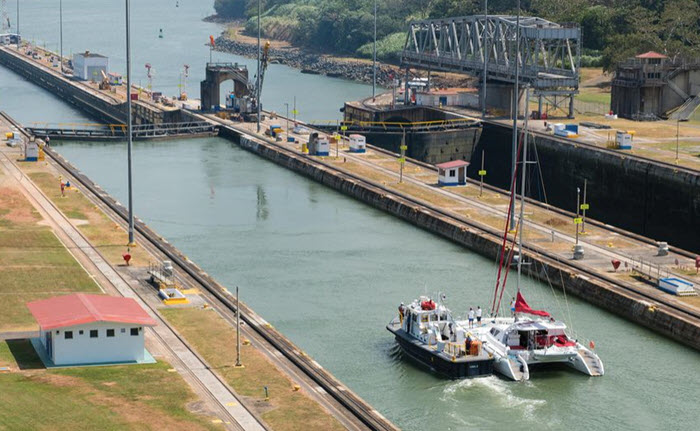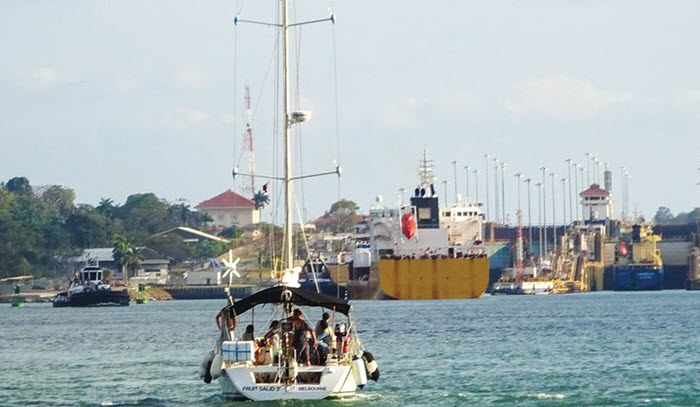Recruited at the last minute for a trip through the Canal, a sailor learns the ropes of how to pass through the locks.
I scrambled out of the dinghy onto Minh’s transom steps as a last-minute addition to the crew, the required fourth line handler needed for a transit of the Panama Canal. The French-flagged 41-foot Fountaine Pajot catamaran was weighing anchor in the Flats anchorage near the Port of Colon, a staging area for vessels preparing to enter the waterway, bound for the Pacific.
Amid a flurry of activity, Bruno, the only English speaker, offered me a kindly welcome aboard as we felt a bump on the port side: Mr. Tito, the rental agent, was delivering four tires wrapped in plastic bags to use as fenders, and four stout 125-foot polypropylene hawsers, which were also necessary for the passage through the canal. In another moment, on the starboard side, a 40-foot steel pilot boat nosed within inches of our hull, and the Canal Authority adviser stepped aboard Minh. Right away, he instructed the captain to get underway and proceed along the 2-mile channel toward the Gatun Locks.
For many cruisers, a transit of the Panama Canal is a milestone accomplishment. The canal itself is an engineering wonder of the world. Completed in 1914, it consists of six locks and 45 miles of waterway, a shortcut between continents connecting the Caribbean Sea and the Pacific Ocean. It is immense in scale. Each lock is 85 feet deep, 1,000 feet long and 110 feet wide. For the original canal, the maximum dimensions for a Panamax vessel—the term used to describe the midsize cargo ships that will fit the locks—are 965 feet long and 106 feet wide. With only 2 feet to spare on each side, there is little room for pilot error. The design of this canal has dictated the parameters for shipbuilding worldwide for nearly a century.
There are three ways a yacht can proceed through the canal. Perhaps the most common is center-chamber lockage, where boats are rafted up two or three abreast. Yachts can also moor alongside a tugboat or small tourist cruise ship. Or they could be tied against the rough cement walls of the canal, less common and also less desirable because water turbulence can crash your rigging into the side wall. Our adviser told us we would raft up for a center-chamber configuration—one less thing to worry about.
As we motored ahead, we prepared the boat by covering the hatches and solar panels with seat cushions and other thick padding to protect them from the monkey’s fists, which are used by canal workers to heave messenger lines to the boats. We were gradually approached by another yacht, the 42-foot Froot Salid from Australia, to which we rafted up, as instructed by the advisers on each boat. Spring and breast lines held us firmly together. We entered the first Gatun lock after the ship ahead of us was secured. Canyonlike walls rose up on both sides. The captains kept the boats centered under the watchful eyes of the advisers, and soon the canal workers atop the high walls threw down the monkey’s fists with messenger lines to be tied to our hawsers. The workers hauled up our lines, and together the men and boats moved slowly forward to the proper position, where the workers secured our lines to bollards.
The advisers and canal workers communicate effectively with each other using walkie-talkies, but also by sharp whistling, reminding me of Scottish shepherds directing their dogs. I jokingly asked our adviser whether a man who couldn’t whistle could get a job here. He thought for a minute, laughed and said, “Probably not.”
In his book The Panama Cruising Guide (fifth edition), Eric Bauhaus gives comprehensive information pertaining to transiting the canal. As a line handler, there were two things I needed to keep in mind. First, having a hawser or any other line go afoul of the prop during the transit is bad—really bad. The water churning around the vessel while the lock is filling is turbulent, made even more dangerous by undercurrents and the mixing of fresh and salt water of different densities. Do not fall in; even if your dog falls overboard or your prop gets fouled, do not enter the water for any reason.
The second hazard is when the monkey’s fist is thrown to your boat. The fist consists of a ball of lead, covered with woven rope, and it’s enough to crack the cranium of the unlucky swabby who wanders into its path. I was vigilant when the lines were thrown to Minh but was startled when the monkey’s fist intended for Froot Salid landed just ahead of me on Minh’s deck!
When all was ready with the ship ahead and our rafted yachts, the massive lock gates behind us slowly closed. These impressive doors weigh 800 tons apiece, and are made from massive steel plates joined by hand-forged and hammer-driven rivets from the Steam Age. They are so precisely balanced on their hinges that only a 40 hp engine is required to open and close them.
When they were closed at last, the water began to swirl up in massive, powerful eddies, and the boats slowly rose. As this happened, the line handlers had to keep a steady tension on the hawsers, holding the boats in position against the turbulent waters. Pressures on the mooring cleats can be tremendous and in an upward direction, which the cleat installations must be able to withstand.
The churning water quieted, the lock was filled, and with a metallic rumble, the lock gate ahead opened. Four chunky electric locomotives, weighing 20 tons each, towed the ship forward into position inside the second lock. Once it was in position, our advisers directed us to move our rafted boats forward. Both vessels motored at dead slow into position, and the canal workers manning the bollards walked the hawsers along the wall and up the steps to the top of the next lock. Sharp whistles reminded us line handlers to raise our lines overhead as workers climbed the steps. When we moved into the canyon of the second lock, our lines were secured and the whole process slowly repeated, and again for the third Gatun Lock. After transiting these three locks, the boat lay 84 feet above the level of the Caribbean Sea from which we had started.
As the evening sky ripened to tangerine and scarlet, we left the third Gatun Lock and headed into Lake Gatun. This meandering lake was formed when the Rio Chagres was dammed to create a navigable waterway leading farther on toward the Pacific. The advisers guided us to a giant mooring float, where both boats moored securely with bow, stern and spring lines for the night. This is more convenient for prompt departures because anchors dropped in Lake Gatun might foul on 100-year-old logs or stumps still rooted beneath the dammed waters. As a chorus of howler monkeys heralded the approach of twilight, I dived overboard for a delicious swim in the sweet fresh water, and was soon joined by everyone on both boats, in spite of rumors about lurking crocodiles. Refreshed and relaxed, the wine was poured, the stars came out, and we slept.
After a French breakfast of coffee with fresh crepes and jam prepared by Annick and Charles-Henri, our advisers rejoined us around 0715 and we resumed our passage. We had to maintain a speed of at least 6 knots to stay on schedule. The well-marked shipping channel meanders just over 20 nautical miles through the lake. We kept to the side, as container ships and roll-on/roll-off ferries—or roros—passed us from both directions. It was a quiet passage, revealing glimpses of jungle vegetation, bird life and the geology of the isthmus as we went. Using a mixture of French, Spanish, Portuguese and English, we crewmembers and our cheerful adviser got to know each other a little better throughout the day.



